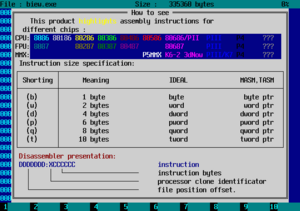Software:Beye
 Beye | |
| Developer(s) | Nickols Kurshev, Andrew Golovnia |
|---|---|
| Stable release | 6.1.0
/ 12 December 2009 |
| Operating system | Cross-platform |
| Type | Utility |
| License | 2013: GPL-2.0-only or GPL-3.0-only[lower-alpha 1][1] 2000: GPL-2.0-only[lower-alpha 2] 1994: Proprietary[lower-alpha 3] |
| Website | beye |
BEYE (Binary EYE, BIEW, Binary View) is a multiplatform portable viewer of binary files with a built-in editor that functions in binary, hexadecimal and disassembler modes. It uses native Intel syntax for disassembly. Features include an AVR/Java/x86-i386-AMD64/ARM-XScale/PPC64 disassemblers, a Russian code pages converter, full preview of MZ, NE, PE, NLM, COFF32, ELF formats, partial preview of a.out, LE and LX, Phar Lap formats, and a code navigator.
History
BEYE was developed in 1994 by Nickols Kurshev[2] and Andrew Golovnia[3] under the name "View". In February of 2010 the program was renamed to BEYE, even though poll votes were mostly against its rename. BEYE's creators stated, that the previous name had some negative associations in English,[4] and the new one doesn't conflict with other projects.[5]
At that time, compilers were not able to create highly optimized executables, and CPUs were not as efficient, which caused many programmers to code in assembly language. In those days many countries, including Russia, had poor accessibility to the Internet, and it was problematic to find information about CPUs. Many programs produced errors and it was too difficult to understand the source of the problems.
After spending a long time trying to understand the causes of the defects in his own programs, the developers of BEYE coded their own disassembler. Perhaps the needs of the creators couldn't have been covered by existing disassemblers, and so he wrote his own.
Initially BEYE was closed-source, but friends helped to improve the project with new ideas, and in some cases with new code. Later, after purchasing a modem, Nickols and Andrew decided to release the source and publish BEYE on the Internet.
In 2000, the sources were published at SourceForge.[5]
Beye no longer works in Windows 11.[5]
Features
BEYE's features include:[4]
- Built-in AVR/Java/x86-i386-AMD64/ARM-XScale/PPC64 disassemblers.
- Saving and restoring parts of files.
- Support for a-out, arch, coff-386, ELF, MZ, jvmclass, LMF, LE and LX, NE, NLM-386, PharLap, PE, RDOFF, SIS and SISX executable formats.
- Instruction high-lighting.
- A code navigator.
- A CPU performance utility
- A built-in 64-bit calculator
- Support for the formats: ASF, AVI, BMP, JPEG, mov, MP3, MPEG, RealMedia, WAV multimedia.
- Console-Input viewer
- Pattern searching in different modes: disassembler, hexadecimal and binary.
- Russian code-page converter.
See also
Notes
References
- ↑ "[r138 meke beye as bi-licensed project"]. 2013-05-18. https://sourceforge.net/p/beye/code/138/.
- ↑ "konst / Profile". https://sourceforge.net/u/konst/profile/.
- ↑ "andrew_golovnia / Profile". https://sourceforge.net/u/andrew_golovnia/profile/.
- ↑ 4.0 4.1 "Beye introduction". Archived from the original on 31 August 2010. https://web.archive.org/web/20100831011645/http://beye.sourceforge.net/en/beye_intro.html. Retrieved 2010-02-27.
- ↑ 5.0 5.1 5.2 beye. sourceforge.net (2010-02-14)
External links
- Beye on SourceForge.net
- Nickols Kurshev's SourceForge page
- Andrew Golovnia's SourceForge page
 |

